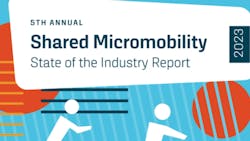NABSA annual micromobility report shows 172 million trips were taken in 421 North American cities
The North American Bikeshare and Scootershare Association (NABSA), the nonprofit membership-based association representing public, private and nonprofit organizations in shared micromobility, celebrated the release of the fifth annual Shared Micromobility State of the Industry Report for North America on Aug. 6.
The 2023 report demonstrates shared micromobility’s continued viability and strength as an important mode in the public transportation ecosystem and shows an industry that continues to grow, mature, electrify and gain efficiencies and effectiveness.
According to the report, shared micromobility ridership across North America, as well as the number of cities with systems, reached its highest annual level to date. In 2023, at least 172 million shared micromobility trips were taken in 421 cities across North America.
“There’s just no two ways about it, shared micromobility consistently delivers, year-over-year-over-year” said NABSA Executive Director Sam Herr. “Communities increasingly view and utilize shared micromobility as an essential mode in a multi-modal network. This is what we need to further climate and equity goals and make our communities more sustainable into the future.”
The report notes total shared micromobility vehicles deployed across North America decreased slightly in 2023 while the number of trips continued to rise, meaning the fleets generally had more rides per vehicle per service day. The higher utilization points to more fleet effectiveness and efficiency.
New to the 2023 report is the capture of how operators are electrifying and incorporating climate-friendly practices into shared micromobility operations. The report notes 67 percent of operators use e-bikes and 46 percent use electric vehicles or hybrid vehicles to rebalance their shared micromobility fleets.
According to the report, shared micromobility continues to be a solution toward transportation decarbonization. In 2023, shared micromobility across North America offset approximately 81 million pounds of carbon dioxide (CO₂) emissions (37 million kilograms) by replacing car trips– 303 million lbs. of CO₂ emissions (137 million kilograms) since 2019– and 37 percent of all shared micromobility trips continue to replace car trips.
The report notes the popularity and use of electric shared micromobility continues to trend upward, as 64 percent of shared micromobility rides in 2023 were taken on an e-device, and 82 percent of systems across North America incorporate electric shared micromobility devices. E-bikeshare trips continue to increase over time, from 7 million in 2019 to almost 40 million in 2023.
Shared micromobility continues to support transit with first/last mile service and make transportation more equitable. The report details 70 percent of riders used shared micromobility to connect to transit, and 20 percent use it weekly to connect to transit. According to the report, 90 percent of shared micromobility systems offer discount programs and 31 percent offer adaptive vehicles.
The 2023 report captures a snapshot of the emerging support of public transit agencies starting and increasing their direct financial investment in shared micromobility services, as well as other financial expenses and operating characteristics.
“We’re at an all-hands-on-deck moment in shared micromobility. Support at state, provincial and federal levels are needed to join in this effort,” Herr said.
NABSA worked with Toole Design and the University of California Berkeley Transportation Sustainability Research Center to help develop the report. The report is composed of survey results, statistics gathered from performance reports released by shared micromobility systems and data from GBFS.
Both an English and Spanish version of the report is available for download here.
